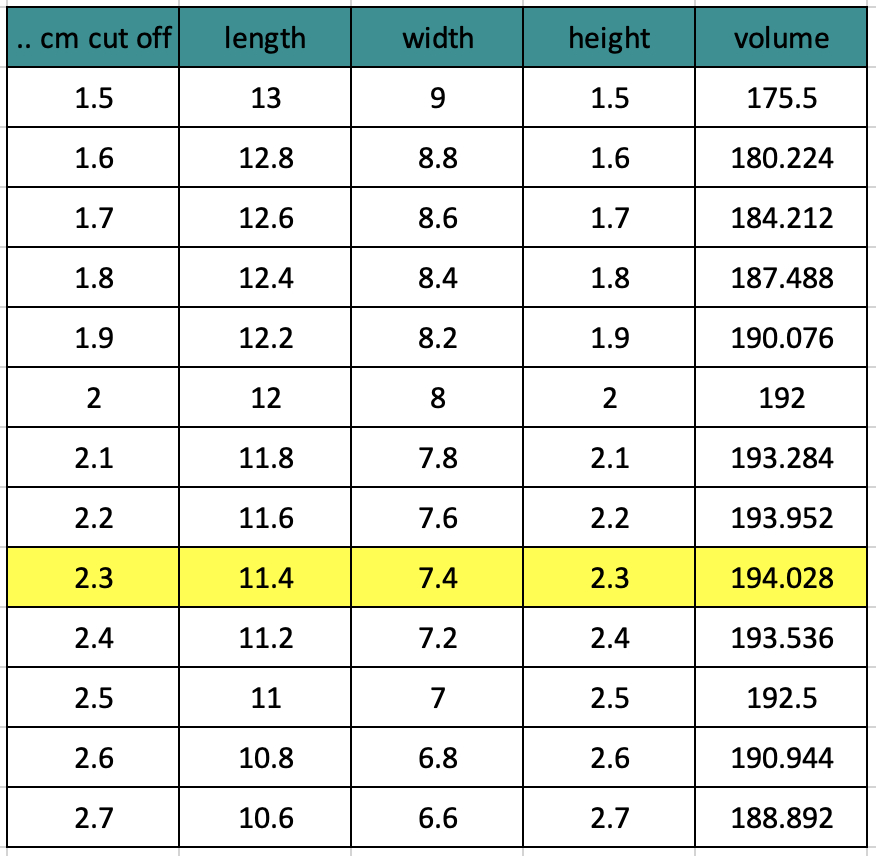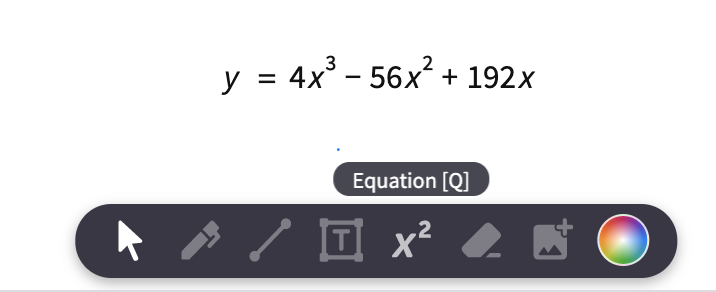Overview and Objective
In this activity, students will work on a famous math problem exploring the volume of an open box. The aim is to create an open box (without a lid) with the maximum volume by cutting identical squares from each corner of a rectangular card. Although this can be viewed as an optimization problem that can be solved using derivation, younger students can still approach the problem using different strategies.
Working on this task will help students improve their skills of working systematically. Students will write a function (or algebraic expression according to the grade level) that describes a relationship between three quantities. For some students, the task can also lead to creating spreadsheets as they explore how to automate solutions.
Warm-Up
Before starting to work on the main problem, a numerical example can be used to clarify the question. A 16 x 12 cm rectangular piece of card is used to create an open box by cutting four identical 3 cm by 3 cm squares from each of its corners. The remaining card is then folded to form an open box. What is the volume of the open box in cm? You may share this canvas with the students to let them work on the problem. Click here to learn how to share Polypads with students and how to view their work.

Take some time to talk about the dimensions of the box. Consider asking questions like:
- What would be the height of the box if we cut 4x4 squares off from each corner?
- What would be the new width and length of the box?
You may use the table tool of Polypad to record the new dimensions after each cut.

Main Activity
Pose this question to students:
A sheet of 16 cm x 12 cm card is used to make an open box. Four identical squares are cut out of each corner. Then, the remaining card is folded to make an open box. Find the size of the cut-off squares that creates the box with the maximum volume.
Before the students start to work on the problem, take some time to talk about possible strategies. Based on the students' mathematical backgrounds, you may use different approaches to work on this problem.

Share this Polypad canvas and allow students time to work on the problem. Initially, working systematically to understand the problem helps students at every level. Start by cutting out a 1 cm square from each corner - what would the volume be? Then a 2 cm square, then a 3 cm square, and so on.

Remind students to use the folding net option to help them decide the new dimensions and calculate the volume.

Ask students to record the new dimensions and the volume of each box using the Table tool of Polypad. Here is an example;

Invite students to share their findings while talking about these questions
- What different volumes can you make by changing the size of the squares?
- What can be the maximum size of the square you cut out? Why?
- How did the volume change with the increasing size of the squares?
- What is the cut-off square size of the open box with the max volume?
- The side length of the square doesn't necessarily have to be a whole number. So how can we be sure that exactly 2 by 2 squares create the boxes with the maximum volume?
After this point, to reach a more precise answer, you may follow different strategies according to students' existing knowledge.
Approach #1
Students with less algebra background can use a spreadsheet or a calculator to perform and record their calculations with decimal values.

The maximum value can be found as 2.3. Here, students still benefit from expressing the values using algebra to create formulas for each column as , , and .
Approach #2
For the students who know about functions and graphing, ask about the volume formula in terms of .
After they write the formula, ask them to simplify the expression using the distributive property. Use the equation writer from the toolbar at the bottom center to write the equations.

Now, insert the coordinate plane into the canvas to make the adjustments. Clarify with the students the min and the max values of can get.
Certainly, we need . Furthermore, the side length of the square cannot be greater than or equal to half the length of the shorter side, 12 cm; otherwise, one of the flaps would be completely cut off. Therefore our boundaries for is
Use these values to arrange the x-axis of the coordinate plane. You can choose the units around 0.4 for the x-axis and 10 for the y-axis. Drag the little blue arrow next to the equation onto the coordinate plane to draw the function's graph.
After sketching the graph, we can find the highest point of the graph as our max volume. The x- coordinate of this point gives us the size of the square needed to be cut off to create that maximum volume. Here, some students may comment on the value between 2.2 and 2.3.
Approach #3
If the students knew about derivatives, remind their use to find more precise numbers in optimization problems.
Now, let them take the derivative, set it equal to 0 to find critical points of the volume function; since we know that , we can graph the derivative of the function on the same coordinate plane.
To have more accurate answers, we can solve the derivative function for .

. Find critical points by setting the derivative equal to 0,
and then using the quadratic formula to solve for x.
. and .
So the critical points of the volume function are x~ 7.07 and x~ 2.263. Remind the students that has to be less than 6 so the side length of the cut-off squares needs to be almost 2.263 cm to maximize the volume of the open box.
Closure
Share some student work with the class. Invite students to share which approaches they found most useful when answering the questions.
To close the lesson, discuss the optimization problems being one of the most common applications of mathematics. Let them think about how frequently they hear or read terms such as greatest profit, minimum cost, least time, and optimum size. They involve the determination of minimum and maximum values of a function in a considerable domain. More precise answers can be found with the help of technology, and advanced techniques in mathematics.
Support and Extension
For students needing additional support with these ideas, consider using smaller sizes of rectangular cards to start with. For students ready for additional extension in this lesson, ask them to find the dimensions of the open box with the minimum surface area that can be created using the same method.
Polypads for This Lesson
To assign these to your classes in Mathigon, save a copy to your Mathigon account. Click here to learn how to share Polypads with students and how to view their work.